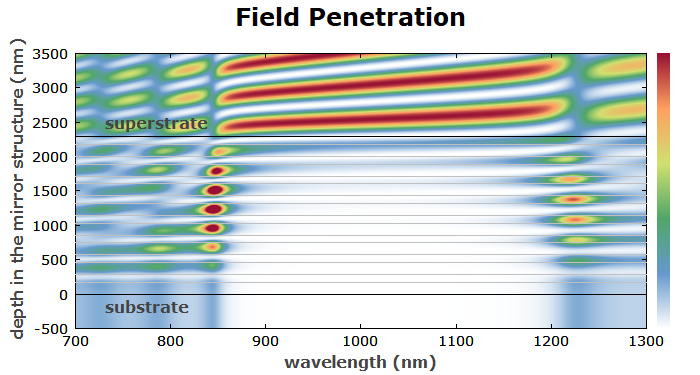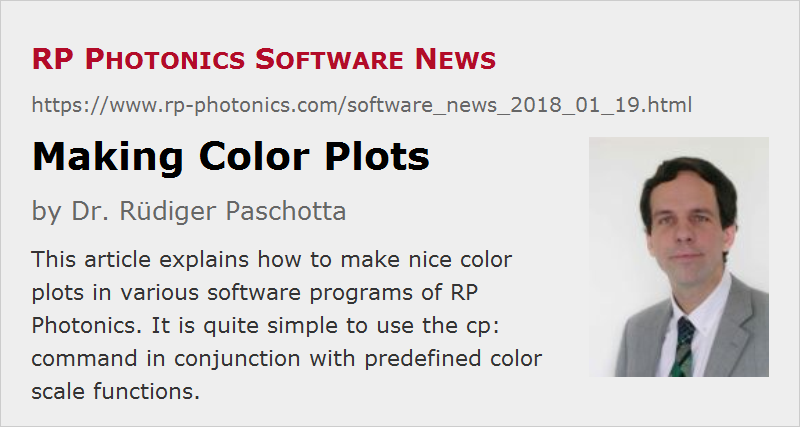Making Color Plots
Posted on 2018-01-19 in the RP Photonics Software News (available as e-mail newsletter!)
Permanent link: https://www.rp-photonics.com/software_news_2018_01_19.html
Author: Dr. Rüdiger Paschotta, RP Photonics Consulting GmbH
Abstract: This article explains how to make nice color plots in various software programs of RP Photonics. It is quite simple to use the cp: command in conjunction with predefined color scale functions.

The most common type of data plot is the x−y plot, where the vertical position (y) of a point indicates some quantitative value depending on the horizontal (x) position. A serious limitation of that is that you can visualize only the dependence on a single variable.
An extension of that is a 3D diagram where you have three mutually perpendicular coordinate axes. Unfortunately, most computer screens are still two-dimensional, and you can then only show a projection of the 3D diagram to the 2D screen. As a result, it becomes hard to read quantitative values from such a diagram; it gives little more than some qualitative impression. It can help only to a limited extent to use something like a mesh, reducing the ambiguity of the projection.
A nice looking solution is to make color plots, where the function value corresponding to each x/y data point is encoded as a color. That avoids the problems of a 3D-to-2D projection and is also technically quite simple to realize. The limitation of that approach is just that our color vision is not that precise; while the projection problem is avoided, precise quantitative values are not obtained.
In this article, I want to show you how to realize such color plots in our software, namely with the products RP Fiber Power, RP Resonator, RP Coating and RP ProPulse.
A Simple Command
Our software offers the simple command “cp:”. In many cases, it is sufficient to give it a mathematical expression which calculates the color value as a function of x and y. An example:
cp: color_I((sin(x) * cos(y))^2)
The predefined function color_I() converts values between 0 and 1 into color values, using a color scale which ranges from white (0) over blue (0.2), green (0.4), yellow (0.6), orange (0.8) to dark red (1).
As another example, the following figure, taken from a case study on a Bragg mirror made with RP Coating, has used the same color scale:

The command used for making this color plot:
cp: color_I((R(x); E2(y)/4)) { color plot }
It again uses the predefined function color_I(), here in combination with the functions R(x) for the reflectivity of a mirror structure at a certain wavelength and the function E2() for the field intensity in the structure. What happens when the expression is evaluated for a certain value of x and y is the following:
- The reflectivity at the wavelength x (here in nanometers) is calculated. That also sets the field intensities throughout the structure. (The reflectivity value itself will be discarded.)
- Thereafter, the field intensity for the given depth y in the structure is returned.
- From that, the color value is calculated according by the color scale function.
That may seem to be a bit tricky in the beginning, but you quickly get used to that technique and can then make a wide range of nice color plots. You can also find a lot of them on this website.
Defining Other Color Scales
Our software offers only two different predefined color scales through the functions color_I() and color_A(). You have seen the former, and the latter accepts a complex argument with a modulus up to 1; the complex phase determines the type of color, and the modulus determines the color saturation. That function can be useful for plotting complex amplitudes, as obtained e.g. from numerical beam propagation.
Of course, there are many other color scales which you might want to use. Here, you have full flexibility, because you can define your own arbitrary color scale functions. As an example, I show you how to implement the viridis color scale as explained here. That color scale is not defined through a simple formula, but rather through tabulated values, which you find in the file colormaps.py from https://github.com/BIDS/colormap/blob/master/colormaps.py.
Here is how you could define the new color function color_viridis(I) in our software:
; Define arrays for the RGB (red-green-blue) color values:
defarray R_viridis[0, 255]
defarray G_viridis[0, 255]
defarray B_viridis[0, 255]
; Read a table of data into those arrays:
j := -1
readlist R_viridis[j := j + 1], G_viridis[j], B_viridis[j]:
0.267004, 0.004874, 0.329415
0.268510, 0.009605, 0.335427
0.269944, 0.014625, 0.341379
; (253 more values not shown here)
; Define the color function, using the arrays:
color_viridis(I) :=
begin
global R_viridis[], G_viridis[], B_viridis[];
var x;
I := maxr(I, 0);
I := minr(I, 1);
x := I * 255;
rgb(R_viridis~[x], G_viridis~[x], B_viridis~[x]);
end
Once that is done, you can simply replace the function color_I() with color_viridis() in your scripts, and the new color scale is used!
This article is a posting of the RP Photonics Software News, authored by Dr. Rüdiger Paschotta. You may link to this page, because its location is permanent.
Note that you can also receive the articles in the form of a newsletter or with an RSS feed.
 |

If you like this article, share it with your friends and colleagues, e.g. via social media:
These sharing buttons are implemented in a privacy-friendly way!